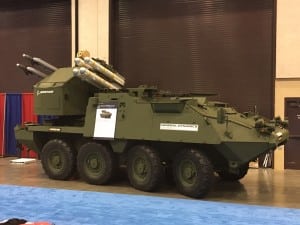
The Army could find the answer to its lack of mobile short-range air defense (SHORAD) in a couple of existing platforms that General Dynamics [GD] Land Systems, with the help of Boeing [BA], have mashed together into a new vehicle.By cutting the back off of a Stryker Infantry Combat Vehicle (ICV) variant and mounting a Boeing-made TWQ-1 Avenger air defense system missile launcher on the back, GD created what it calls the Stryker Mobile SHORAD Launcher. Boeing supplied an interface…

 By
By 











